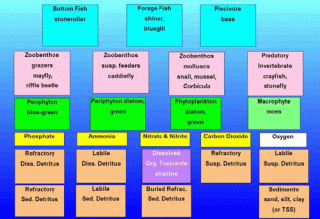What does AQUATOX do?
- Ecological components simulated by AQUATOX
- Aquatic ecosystems represented by AQUATOX
- Ecological processes simulated by AQUATOX
AQUATOX simulates the transfer of biomass, energy and chemicals from one compartment of the ecosystem to another. It does this by simultaneously computing each of the most important chemical or biological processes for each day of the simulation period; therefore it is known as a process-based or mechanistic model. AQUATOX can predict not only the environmental fate of chemicals in aquatic ecosystems, but also their direct and indirect effects on the resident organisms. Therefore it has the potential to establish causal links between chemical water quality and biological response and aquatic life uses.
AQUATOX differs from most water quality models in several ways. Most models include few if any biological components, whereas AQUATOX is an ecosystem model. It includes not only numerous types of plants, invertebrates and fish, it also treats the biota as interacting with the chemical/physical system. As mentioned above, AQUATOX is a process-based model, as opposed to empirical models, which are often based on statistical relationships. Empirical models may establish that correlations between variables exist, but do not explain why, or explain the mechanisms of the relationship.
Ecological components simulated by AQUATOX
AQUATOX can model numerous inter-related components in aquatic ecosystems, known as the state variables.
- Phytoplankton (multiple species)
- Periphyton and submerged aquatic vegetation (multiple species)
- Planktonic and benthic invertebrates (multiple species)
- Forage, game, and bottom fish (multiple species)
- Nutrients and dissolved oxygen
- Organic and inorganic sediments
- Toxic organic chemicals (up to 20 different chemicals simultaneously)
- Perfloroalkylated Surfactants (bioaccumulation only)

AQUATOX is not intended to include every species of plant or animal that can exist in an aquatic habitat or every ecological process, but attempts to characterize the significant factors that determine the functioning of the ecosystem.
Aquatic ecosystems represented by AQUATOX
- Lakes and ponds (may be vertically stratified)
- Reservoirs (may be vertically stratified)
- Rivers and streams
- Estuaries
- Experimental ponds and enclosures ("mesocosms")
Multiple AQUATOX river, lake, reservoir, or estuarine segments may be linked into a single simulation, tracking the flow of water and the passage of state variables from segment to segment. AQUATOX assumes that individual segments are uniformly mixed, except where vertical stratification occurs in lakes and reservoirs due to temperature difference, and in estuaries due to salinity.
Ecological processes simulated by AQUATOX
AQUATOX is a process-based model, meaning that it explicitly simulates the numerous biological and ecological processes that operate to link the ecosystem together. In this way it predicts the environmental fate and ecological effects of the various environmental stressors.
Biological effects
- Photosynthesis
- Food consumption
- Respiration
- Growth and reproduction
- Natural mortality and mortality from high temperature, low dissolved oxygen, or salinity that is either too low or too high
- Lethal and sublethal toxicity from organic toxicants and ammonia
- Trophic interactions (food preferences)
- Changes in biological communities under changing environmental conditions
- Sloughing of periphyton due to high stream velocity
- Smothering of organisms by suspended and bedded sediments
Environmental fate
- Nutrient cycling and oxygen dynamics
- Release of phosphorus from anaerobic sediments
- Calcite precipitation and removal of phosphorus under alkaline conditions
- Partitioning of organic toxicants to water, biota and sediments
- Toxic organic chemical transformations
- Bioconcentration and bioaccumulation through gills and diet
